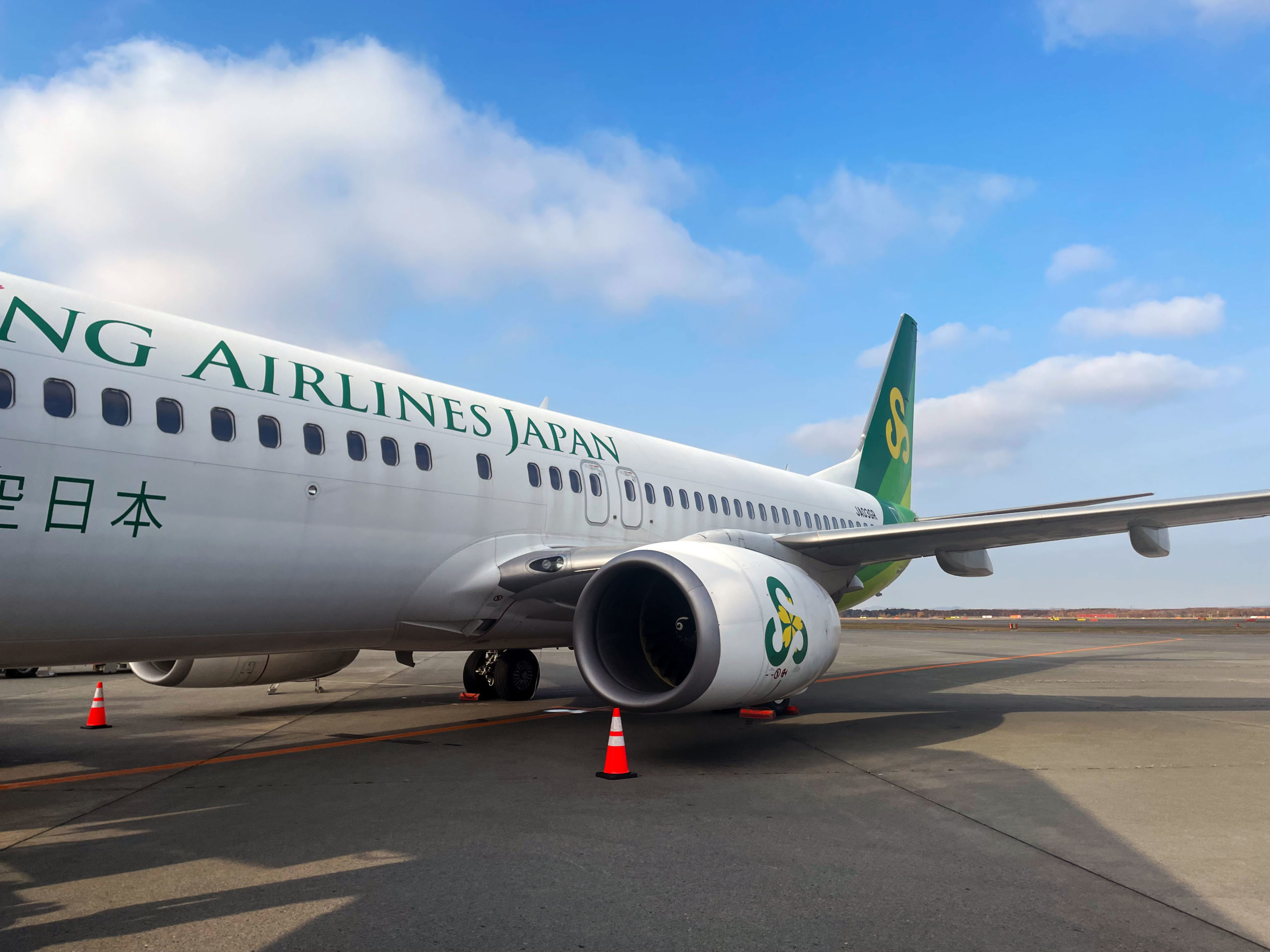
Spring Airlines flight details
Airline : Spring Airlines Japan
Flight No : IJ835
Departure City : Tokyo – Narita (NRT)
Arrival City : Sapporo – New Chitose (CTS)
Equipment : Boeing 737-800 (JA03GR)
Blocked Time : 1h50m
Seat No: 1F
Spring Airlines Japan (IJ) is the Japanese arm of the Chinese low-cost carrier, Spring Airlines. The airline was founded in 2012 as a joint venture between Spring Airlines and various Japanese investors. Unlike the all-Airbus Spring Airlines China, however, Spring Japan operates a small fleet of Boeing 737-800s in an all-Economy Class configuration, all delivered new to the airline. In 2021, the airline became majority-owned by Japan Airlines. The airline is based at Tokyo Narita International Airport (NRT), operating out of the low-cost Terminal 3.
While I’ve seen Spring Japan’s Boeing 737s many times in Narita, the airline has always seemed elusive to me – at least compared to Japan’s other regional airlines and low-cost carriers. Despite being a Japan Airlines subsidiary, it doesn’t get as much attention as Jetstar Japan or ZIPAir and has few reviews on the internet. So finally getting to fly Spring Japan does feel like a treat!
Booking Spring Airlines Japan
While Spring Airlines Japan only offers one class of service, it does have three fare types – Lucky Spring, Spring, and Spring Plus. The highest of the three is Spring Plus, which includes priority check-in, priority boarding, front-row seats, and a 30 kg checked baggage allowance. I booked this ticket on their official website since Spring Airlines does not show on OTAs. Whilst the website is easy to use, I did not like that I had to create an account to book a ticket.
Ultimately, I paid JPY 11,040 (~USD 75, GBP 60) for this one-way flight from Narita to Sapporo in Spring Plus. This includes a payment fee of JPY600. For reference, a no-frills Lucky Spring ticket would cost JPY 7,040 (~ USD 48, GBP 38), meaning that Spring Plus carries a roughly 55% premium.
Narita Airport Terminal 3
After checking out from the Grand Prince Hotel Takanawa, I took the Narita Express (N’EX) from Shinagawa Station to Narita Airport Terminals 2 and 3 Station. We effectively alighted at Terminal 2, since Terminal 3 does not have its own dedicated train station. From Terminal 2 Station, it was a roughly eight-to-ten-minute walk to Terminal 3 in a covered walkway.
The Muji-designed Terminal 3 is Narita Airport’s dedicated low-cost terminal, housing flights operated by AeroK, AirAsia, Jetstar, Jeju Air, Spring Airlines, and Spring Japan. Opened in 2015, Terminal 3 is adorned with indoor running track decals, as a nod to the 2020 Tokyo Olympics. By the entrance is an art installation, alongside several paid coin-lockers. Thoughtfully, a free weigh scale and a repacking table are provisioned at various points in the terminal. This is not something you commonly see at many airports, particularly not at a low-cost terminal!
Check-in
For this 12.25 departure, I got to Narita Airport’s Terminal 3 at 10.05 and headed straight to Island F, where the airline’s check-in counters are. This was frankly way too early since the check-in counters for Spring Japan flights only open 90 minutes before departure, as I later learned. It is not possible to check in before that as the counters and the check-in kiosks are blocked off beforehand. At the entrance is a nifty chart with all the timings for Spring Japan flights.
At precisely 10.40, the queue for check-in was opened for passengers to line up. Five minutes later, passengers in the queue are requested to weigh their carryons before proceeding to the automated check-in kiosks. The process is very straightforward, as it involves scanning your ticket barcode, after which your boarding pass and bag tag (if any) are automatically printed. If you have bags to check in then you could proceed to the counters to drop them off. Curiously, there isn’t a dedicated priority counter for Spring Plus, as suggested on their website.
Boarding
Terminal 3 Food Court
After check-in, we headed to the far end of the terminal, where the entrance to the departure gates is located. Since I still had time to spare, I decided to get some food at Terminal 3’s expansive food court before clearing security. This ended up being a good decision since there aren’t any restaurants or food outlets airside. Continuing with the terminal’s thoughtful trend, the food court had some great outlets, all of which charged roughly the same price as any place in downtown Tokyo. Frankly, this is a welcome change to the outrageous food prices in other Asian airports (looking at you, Ngurah Rai, Bali!)
Boarding
I headed airside 15 minutes before our printed departure time, where I found a spartan gate area. The seats slowly filled as we approached our boarding time of 11.45, by which time a Spring Japan agent showed up. At 11.51, pre-boarding started, inviting passengers requiring special assistance to board. This was followed by general boarding at 11.55, in which Spring Plus passengers were invited to board first.
The Spring Plus Priority Boarding feature soon proved to be futile since we would be taken by bus to the plane. Furthermore, the bus only left after every square inch was filled with passengers. While not very comfortable, this was not unexpected from a low-cost carrier. When we did get going, we passed by an AeroK A320 destined for Cheongju. Also notice that AeroK is Korea spelled backwards. Hah, how clever is that!
It was then a quick five-minute shuttle to the Spring Japan jet taking us to Hokkaido. Our flight today is operated by JA03GR, a Boeing 737-800 delivered new to the airline in 2014. For one, there’s something about the livery that I loved, which only added to my excitement heading up the stairs to the aircraft. Ah, it sure feels very thrilling to fly an airline I haven’t flown before!
At the door, I was greeted by a friendly flight attendant, who welcomed me on board this flight to Sapporo New Chitose – so far so good!
Spring Airlines Japan 737-800 Cabin
Spring Japan’s Boeing 737-800s are equipped in a standard all-Economy Class 3-3 configuration. The aircraft features a dense configuration of 189 seats, the same number of seats you’d find on other low-cost carriers like Lion Air, RyanAir, and TransAvia. The grey-decked leather seats are pretty no-frills although are otherwise clean and well-maintained.
In particular, the first three rows feature extra legroom and carry a higher seat selection surcharge than the standard seats. Of course, these seats can be selected for free with a Spring Plus ticket. Otherwise, these seats can be selected for a supplementary charge, with front-row seats going for JPY 1200 (~ USD 8, GBP 6.5) and rows 2-3 for JPY 900 (~ USD 6, GBP 5) on domestic flights. For reference, standard seats can be selected in advance for JPY 500 (~ USD 3.5, GBP 3), which seems standard.
While I was seated in the first row, I quickly went to an empty Row 3 to test out the legroom of these seats. With myself standing at 180 cm (5’11), there was a whopping 15 cm (~ 6 inches) between my knees and the seatback. This all made sense given the advertised seat pitch of an exceptional 84 cm (33 inches). If you ask me, the JPY 900 surcharge is well worth it compared to the abysmal 71 cm (28 inches) pitch in the standard seats!
First-row Comfort Seat
As you’d expect, there is an excellent amount of legroom at my seat back in the first row. In particular, there was more than 40 cm (16 inches) of legroom between my knee and the bulkhead. While this was of course very nice, I felt like the extra 15 cm in the ‘Legroom Seats’ in rows 2-3 is already very good to begin with. As such, I’d probably book those seats next time so that I don’t have to go through the hassle of putting all my belongings in the overhead compartments.
In the absence of a seatback pocket, a literature pocket is attached to the bulkhead wall in front. Furthermore, the tray table is pulled out of the centre armrest, as is standard in any front-row seat. The table is adequately-sized and sturdy enough to accommodate a laptop and serve as a working surface, despite being folded.
In the literature pocket is the safety card and a typical onboard menu catalogue, which I’ll expand on in a bit. There was also an airsickness bag, which you don’t see on a lot of low-cost carriers.
In addition to the excellent legroom of the premium seats, I appreciated that the seat had good padding and was quite comfortable to sit on. Individual air vents are also available on the overhead bins, which is always appreciated.
Departure from Narita
As boarding went underway, dramatic orchestral music was playing in the background, interjected by regular automated welcome announcements in Japanese, Mandarin Chinese, and English. At 12.14, the door was closed, just one minute before our scheduled departure time. The cabin ended up being about 90% full, though many premium seats were left with empty middle seats. By this point, the purser went on the intercom to welcome us onboard, detailing the flight time of 1 hour and 15 minutes.
Pushback and Taxi
By 12.18, the purser began narrating the safety instructions by memory, as her juniors conducted the manual safety demonstration. At this time, we started our pushback, leaving the stand just three minutes past our scheduled departure time. We passed by the AeroK A320 as well as a Philippines AirAsia A320 as we left Terminal 3.
As we taxied to the runway, we passed by a bunch of interesting traffic, including a Juneyao Air A321-200 and a China Airlines A321neo at Terminal 2. Then, we slowly taxied past Terminal 1, where several ANA Boeing 787-9s were parked up in remote stands. I’ve previously reviewed ANA’s Boeing 787-9 in Business Class.
The most interesting planes were probably the Korean widebodies – an Asiana Airlines A380-800 and a Jin Air Boeing 777-200ER. While I know that Jin Air is the low-cost subsidiary of Korean Air, I had no idea that Asiana flies its A380s to Narita. This has got to be one of the shortest commercial A380 flights out there!
Takeoff
A Scoot Boeing 787 from Singapore landed on the runway just as we were taxiing parallel to the runway. After nearly 20 minutes after the pushback sequence, we finally arrived on Runway 34L. Our Boeing 737-800 slowly began to roll off the runway, passing the many cargo Boeing 747-8s nearby, before we finally took off at 12.37.
Inflight service
The seatbelt signs 13 minutes after takeoff, prompting the cabin crew to start preparing for the onboard sales service. Before the cart rolled down the aisle, the purser passed through the cabin with an iPad showing a no-smoking announcement. Interesting… Five minutes later, she came back on the intercom to announce in Japanese the details of inflight snacks and drinks available for purchase on board.
Before takeoff, I had consulted Spring Japan’s buy-on-board menu, which is called Bistro Spring. Payments are cash-only and both Japanese Yen and Chinese Yuan are accepted. For one the prices seemed alright for an inflight sales menu and I was very curious about the Rice Porridge with Salmon. Unfortunately, none of the options on the catalogue were available on the flight since Spring Bistro was specifically for international flights only.
Instead, the only snacks on sale were those box-packaged, Omiyage-style, along with a bunch of soft drinks. To be specific, boxed Kyoto Mitarashi dango and senbei are offered on this flight. Uninterested in the selection, I decided to save my appetite for some excellent seafood rice bowls in Sapporo. As I tried to pass the time, I noticed on the Spring Bistro menu that Spring Japan has an ‘Official Ambassador’ mascot of sorts. The character does not have a discernible name and more bizarrely yet, I haven’t seen it used anywhere outside this inflight catalogue.
Lavatory
As the inflight sales trolley progressed towards the back of the cabin, I took the opportunity to check out the lavatory. Spring Japan Boeing 737-800s are equipped with three lavatories, one of which is located at the front of the cabin. I found the lavatory to be bright, pristinely clean, and well-kept. Curiously, Spring Japan also provides extra airsickness bags and female hygiene products – very generous for a low-cost carrier!
Arrival in Sapporo
About 45 minutes before landing, the captain made his first announcement, announcing our descent and the details of our arrival at 14.05. This prompted the cabin crew to wrap up the inflight service, quickly passing through the cabin to collect refuse and prepare the cabin for arrival.
The seatbelt signs were turned on 10 minutes later, by which time the cabin crew were already seated and strapped, ready for landing. As we approached Sapporo, my eyes were glued outside the window as we passed the surrounding suburbs and some very breathtaking autumn foliage. I’m not sure why but something about Hokkaido’s landscape and architecture really reminds me of Scandinavia.
Arrival at New Chitose Airport
About two minutes before we landed, the captain announced that we were on our final approach and asked the cabin crew to be seated for landing. The purser then repeated the safety announcement to remind everyone to stay seated with their seatbelts put on. At 13.53, we finally landed at Sapporo New Chitose Airport, arriving with a rough touchdown.
As we taxied to our parking stand, the purser welcomed us to Sapporo and thanked us for flying with Spring Japan. We ended up parking on a remote stand next to a J-Air Embraer E190 and a blue Fuji Dream Airlines Embraer E170. The forward door was opened four minutes later and I thanked the crew as we disembarked the aircraft.
Waiting for us on the apron was a bus which soon took us to the arrivals area in the main terminal. On the way, we passed by a couple Fuji Dream Airlines E170s and a Skymark Boeing 737-800, both airlines I hope to fly on soon. There was also a Jetstar A320, which I will be reviewing on my way back to Tokyo!
Verdict
Overall, I had a very pleasant flight on Spring Airlines Japan. Having gone on with no expectations, I was pleasantly surprised with the clean cabin, the comfortable and well-padded seats, and the friendly crew. Given the affordability of the flight, I’d say that this flight should be a fair benchmark of a perfect flight with a low-cost carrier. Since Spring Japan is also often the cheapest option on any given route, I left the flight deeply impressed with the value and airline overall. So would I fly with them again? Absolutely!


Leave a Reply